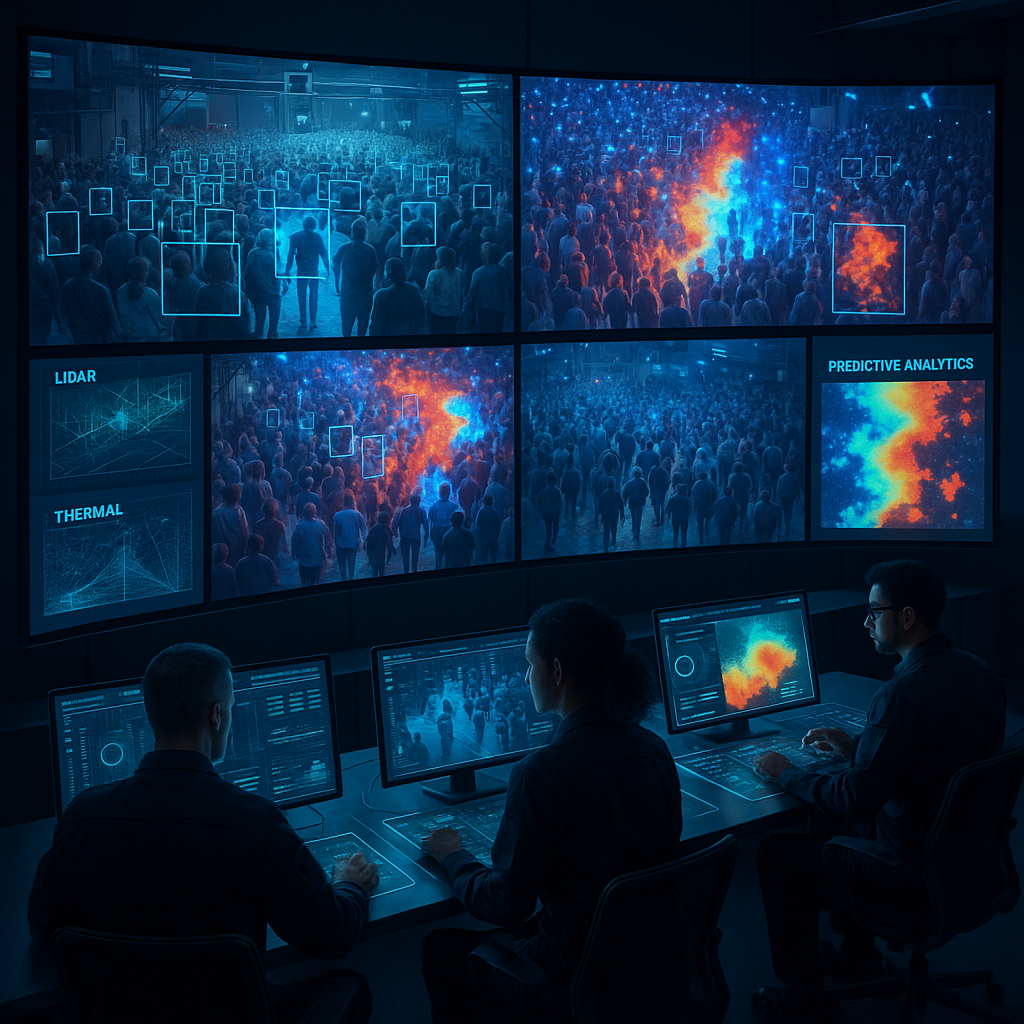Key Takeaways
As algorithms become deeply interwoven with the rhythms of daily life, their incursion into sacred spaces compels us to reexamine fundamental questions of meaning, ritual, and the limits of technology. These key takeaways act as a navigational chart for this provocative convergence, illuminating the unique challenges and opportunities that emerge where ancient traditions encounter artificial intelligence.
-
Algorithms disrupt ritual boundaries: The integration of algorithmic processes into sacred settings, spanning houses of worship to ceremonial events, prompts questions about what qualifies as sacred and who—or what—should wield authority in ritual practice.
-
Rituals are transformed, not erased, by AI: Rather than obsoleting traditions, algorithms are reinventing sacred experiences. They augment rituals, mediate participation, and foster new spiritual expressions that blend code with custom.
-
Human intention collides with machine logic: The deployment of AI in sacred contexts elicits deep philosophical debates over what makes a ritual authentic, notions of agency, and the interplay between human intentions and algorithmic logic.
-
Algorithmic mediation reshapes belonging: Technologies now reconfigure how religious communities gather and connect. Virtual congregations flourish, presenting new questions about coherence, identity, and collective memory.
-
The sacred becomes porous in a digital age: Algorithmic systems expose previously private or protected rituals to wider audiences, making them more accessible but also subject to scrutiny. Vital debates around privacy, consent, and spiritual autonomy are reignited.
-
Reimagining authority in an algorithm-driven era: As code curates or enacts rituals, long-standing questions of leadership and stewardship become newly relevant. Communities are called to collectively redefine what sets spiritual meaning and guides practice.
-
Ritual innovation or cultural loss—a paradox: Whether algorithms enrich or erode cultural depth depends on adaptation and critical engagement. Technology is not neutral, especially where society invests its deepest meaning.
These insights invite us to explore how the intertwining of ritual, meaning, and community life is being radically reimagined in the age of algorithms. They urge ongoing reflection about what we choose to hold sacred as boundaries between human and machine grow more fluid.
Introduction
A sacred chant reverberates through ancient halls, but this time, an algorithm adjusts its pitch and shares the experience across continents. Once the realm of speculative fiction, AI in sacred spaces is now a reality, redrawing the line between tradition and technology. This convergence compels us to question: what, if anything, remains untouched when silicon meets the soul?
The presence of AI is not erasing rituals; instead, it challenges and reinvents the essence of communal gatherings, reshaping spiritual authority and lived experience. Algorithms now mediate acts once reserved solely for human devotion, activating urgent questions about authenticity, agency, and belonging. In a world where the sacred can be coded, curated, or even surveilled, we must consider what happens when our most enduring rituals encounter the algorithms of the digital era. This exploration reveals both disruption and profound renewal, as practices once thought unchangeable adapt to the logic of the present.
Stay Sharp. Stay Ahead.
Join our Telegram Channel for exclusive content, real insights,
engage with us and other members and get access to
insider updates, early news and top insights.
 Join the Channel
Join the Channel
The Digital Transformation of Sacred Rituals
The fusion of algorithms with spiritual customs signals a profound evolution in humanity’s approach to the divine. Traditional worship settings now feature technologies from automated prayer reminders to intelligent lighting that simulates sunrise and sunset during services. These interventions are more than pragmatic; they represent a visionary reimagining of sacred space for the digital world.
Global examples abound. In the Vatican, machine learning preserves and digitizes ancient manuscripts, making centuries-old wisdom newly accessible. Japanese Buddhist temples employ AI-driven chatbots to answer spiritual questions, creating new hybrid spaces where technology and tradition coexist. Hindu temples leverage data-driven crowd management during festivals, ensuring safety while preserving communal essence. Synagogues use algorithms to curate personalized Torah study sessions, blending ancient practice with contemporary insight.
Across these diverse settings, algorithms augment spiritual life while provoking deep conversations about the boundary between authenticity and innovation.
Algorithmic Mediation of Spiritual Experiences
The impact of algorithms on spiritual experience transcends convenience and fundamentally alters how individuals interact with the sacred.
Digital Prayer and Meditation
Spiritual practice today increasingly relies on algorithmic guidance. Meditation apps leverage machine learning to interpret biofeedback—heart rate or brainwave activity—adjusting ambient sounds and visual stimuli to deepen focus. Smart prayer beads equipped with sensors count repetitions and synchronize with mobile platforms, bridging ancient contemplative tradition and modern data-driven insight.
Virtual prayer rooms and immersive meditation chambers represent a new frontier. These environments respond in real time to users’ emotional and physiological states, shifting lighting or soundscapes to induce a sense of the transcendent. This personalization of the sacred was unimaginable until the recent convergence of biometric and algorithmic technology.
Healthcare practitioners now collaborate with spiritual communities to integrate mindfulness and AI-powered meditation for patient wellness. Educators, too, introduce algorithm-driven meditation to help students build emotional resilience, expanding the intersection of spirituality, health, and learning.
Automated Ritual Management
In many faiths, complex ritual schedules are now delegated to specialized algorithms. These systems calculate prayer times across multiple zones and oversee logistics for major ceremonies. During the Hajj pilgrimage, algorithms analyze real-time crowd flows for safety and orderly rituals. Synagogues and churches use similar systems to coordinate community events, while Buddhist festivals employ AI to arrange offerings and ceremonial sequences.
Healthcare institutions use AI scheduling tools to connect spiritual care providers with patients at optimal times. Legal and correctional facilities rely on digital scheduling of multi-faith observances, ensuring equitable access and fostering inclusion.
The Algorithmic Reshaping of Religious Authority
Traditional hierarchies within religious institutions confront new questions as artificial intelligence assumes roles once reserved for clergy. AI now offers personalized spiritual advice, generates thematic sermons, and interprets sacred texts.
This transition forces a reevaluation of religious authority. Some communities leverage AI as a supplemental tool, while others experiment with radical models, allowing code to curate ritual or even deliver blessings. In some Buddhist traditions, robotic monks perform recitations, blending ancestral chants with digital articulation.
Faith-based investment groups use algorithms to interpret ethical guidelines rooted in scripture, automating compliance with religious mandates. Educational institutions integrate AI-guided theology discussions, broadening participation and challenging students to examine embedded hierarchies.
The implications are profound. These hybrid models invite ongoing debates over authenticity, the nuances of empathy, and the evolving definition of stewardship.
Sacred Data and Divine Computation
The Quantification of Faith
Modern faith communities now generate vast amounts of data. Attendance patterns, digital engagement statistics, and sentiment analysis of online sermons inform community outreach and the timing of sacred events. While such quantification unlocks unprecedented insights into religious behavior, it introduces complex ethical dilemmas: privacy, data ownership, and the sanctity of spiritual life.
Healthcare chaplains track well-being outcomes via digital metrics, while marketers analyze public sentiment on religious holidays to optimize engagement. In education, student participation in online religious studies is monitored to detect trends, raising questions about the limits of algorithmic insight in sacred settings.
The challenge lies in balancing data’s advantages with the responsibility to honor confidentiality and the personal nature of religious expression.
Stay Sharp. Stay Ahead.
Join our Telegram Channel for exclusive content, real insights,
engage with us and other members and get access to
insider updates, early news and top insights.
 Join the Channel
Join the Channel
Algorithmic Interpretation of Sacred Texts
Natural language processing applies computational rigor to sacred text interpretation, revealing patterns traditional reading might miss. By cross-referencing scriptures with historical commentary and linguistic context, algorithms enable fresh perspectives in biblical, Quranic, and other scriptural studies.
This algorithmic exegesis is revolutionizing scholarship and accelerating curriculum development in education. Legal professionals employ NLP to examine ethical precedents in centuries of canon law, fostering new interdisciplinary bridges. However, the question remains: can algorithms, lacking lived spiritual experience, genuinely grasp the layers of meaning that define the sacred?
Cultural Implications and Ethical Considerations
Preservation versus Innovation
As technology meets tradition, communities must weigh preservation against adaptation. Digital documentation secures endangered languages and rituals for the future, while algorithmic tools revitalize dormant traditions, making them accessible to diaspora communities worldwide.
At the intersection of culture and outreach, digital dissemination of sacred music or imagery expands audiences but sparks debates over commodification and cultural appropriation. Environmental organizations digitize indigenous rituals as part of conservation initiatives—both preserving heritage and raising new questions about context and consent.
The underlying tension persists: Does innovation enhance the sacred, or risk diluting its meaning?
Privacy and Sacred Surveillance
The adoption of AI and smart tech in sacred contexts brings benefits—improved security, better logistics, and accessibility for people with disabilities—but also unprecedented surveillance. Facial recognition, attendance tracking, and biometric authentication at gatherings may erode the sense of sanctuary that underpins spiritual life.
Legal professionals help religious organizations draft transparent privacy policies. Financial advisors guide charitable platforms to ensure sensitive donor information is protected. These collaborations underscore the need for thoughtful governance and meaningful consent within digitally mediated sacred spaces.
Impact on Religious Communities
Algorithms are redrawing the contours of religious belonging and practice. Online prayer circles, virtual congregations, and live-streamed rituals dissolve geographic distance, connecting those once isolated. Faith communities use AI-powered platforms to match volunteers with opportunities, enhance charitable giving, and support multilingual worship.
Hospitals form spiritual support networks powered by algorithmic triage, matching patients with chaplains aligned to faith and culture. In education, students participate in virtual interfaith dialogues moderated by AI, nurturing understanding in globally distributed classrooms.
This new digital spirituality demands new skills. Religious leaders must become conversant in technology, ensuring meaningful and safe engagement with emerging tools. Communities face the need to foster digital literacy, ethical discernment, and maintain authentic connection amid screens and data streams.
Conclusion
As algorithms reverberate through the world’s sanctuaries, we witness a transformation—not only in ritual mechanics, but in the meanings we attach to the sacred. Adaptive meditation chambers, algorithmic counsel, and data-driven worship practices signal new paradigms of experience, while also surfacing complex debates around privacy, authenticity, and communal memory.
The quantification of belief and computational reading of age-old texts force us to reconsider the hierarchies and boundaries that long defined spiritual life. Sacred spaces are now shaped not only by geography or ceremony, but also by the interplay of data streams, digital participation, and human longing.
Looking ahead, the future of the sacred will be shaped by those able to balance reverence with reason, nurturing community amid rapid change. Faith communities—and the societies they inhabit—are called to anticipate the ethical, philosophical, and practical implications of algorithmic presence. The next era belongs to those who can adapt skillfully and thoughtfully, making technology a tool for deepening meaning rather than eroding it. In this age of digital ritual and mediation, the most vital question is not whether we can preserve the sacred, but how we will choose to reimagine and embody it as human and algorithmic minds converge.





Leave a Reply